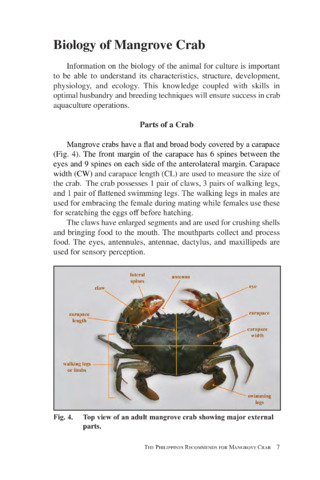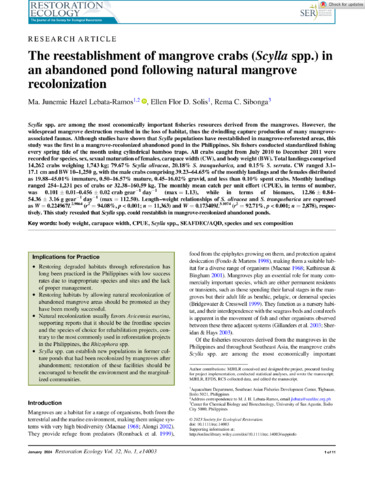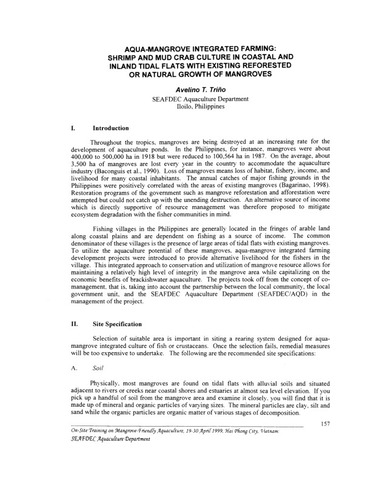Mud crab (Scylla serrata) culture in tidal flats with existing mangroves
- Global styles
- MLA
- Vancouver
- Elsevier - Harvard
- APA
- Help

Date
2000Page views
9,874ASFA keyword
AGROVOC keyword
Taxonomic term
Metadata
Show full item record
Share
Abstract
The performance of the mud crab Scylla serrata (Forsskal) in 200 m2 pens installed in tidal flats with existing mangroves was determined in a factorial experiment with stocking density (0.5 or 1.5/m2) and feed (salted fish by-catch or a mixed diet of 75% salted brown mussel flesh and 25% salted fish by-catch) as main factors. Duration of the experiment was 160 days. Results showed no interaction between feed and stocking density so data were pooled for each feed and stocking density treatment. There was no significant differences in growth, feed conversion ratio (FCR), survival, and production among two types of feed. Regardless of feed, the FCR was significantly more efficient and survival significantly higher at 0.5 than at 1.5/m2 stocking density. Growth, however, was not significantly different. Cost-return analysis on a per crop/200 m2 basis showed that the use of either of the two stocking density levels with either of the two types of feed was economically viable with a return on capital investment of 65-87%. Partial budgeting analysis, however, revealed that net earnings were increased by P1,128.00 if crabs were stocked at 1.5/m2 and P881.00 if fed a mixed diet of 75% salted brown mussel flesh and 25% salted fish by-catch compared with crabs stocked at 0.5/m2 and fed salted fish by-catch alone.
Suggested Citation
Triño, A. T., & Rodriguez, E. M. (2000). Mud crab (Scylla serrata) culture in tidal flats with existing mangroves. In J. H. Primavera, L. M. B. Garcia, M. T. Castaños, & M. B. Surtida (Eds.), Mangrove-Friendly Aquaculture: Proceedings of the Workshop on Mangrove-Friendly Aquaculture organized by the SEAFDEC Aquaculture Department, January 11-15, 1999, Iloilo City, Philippines (pp. 171-176). Tigbauan, Iloilo, Philippines: Aquaculture Department, Southeast Asian Fisheries Development Center.
Type
Conference paperISBN
9718511423Collections
Related items
Showing items related by title, author, creator and subject.
-
[The Philippines recommends for mangrove crab:] Biology of mangrove crab
The Mangrove Crab Technical Committee 2018 (DOST-PCAARRD, 2021) -
The reestablishment of mangrove crabs (Scylla spp.) in an abandoned pond following natural mangrove recolonization
Scylla spp. are among the most economically important fisheries resources derived from the mangroves. However, the widespread mangrove destruction resulted in the loss of habitat, thus the dwindling capture production ... -
Aqua-mangrove integrated farming: Shrimp and mud crab culture in coastal and inland tidal flats with existing reforested or natural growth of mangroves
Triño, Avelino T. (Aquaculture Department, Southeast Asian Fisheries Development Center, 2000)Throughout the tropics, mangroves are being destroyed at an increasing rate for the development of aquaculture ponds. In the Philippines, for instance, mangroves were about 400,000 to 500,000 ha in 1918 but were reduced ...







